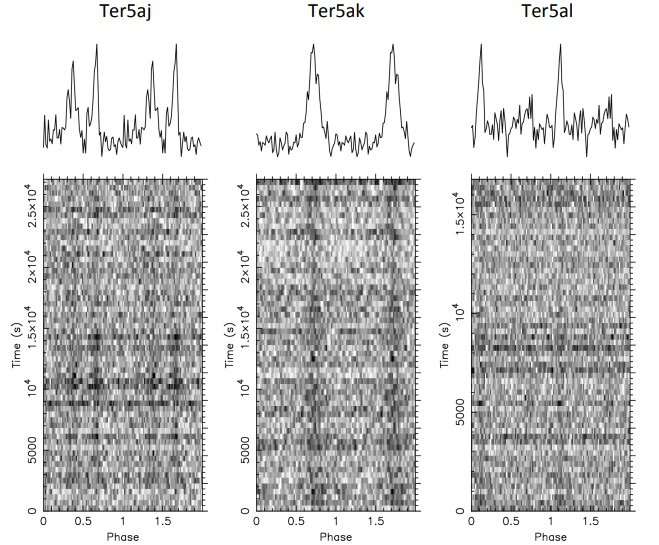February 6, 2018 report
Three new millisecond pulsars discovered in Terzan 5 globular cluster

An international team of astronomers has found three new millisecond pulsars (MSPs) in a Milky Way globular cluster called Terzan 5. The new discovery increases the number of identified pulsars in Terzan 5 to 37 and makes this cluster the most efficient factory of MSPs in the galaxy known to date. The finding is reported January 30 in a paper published on arXiv.org.
Millisecond pulsars spin rapidly, at hundreds of times per second. Astronomers searching for new MSPs focus their observations on globular clusters (GCs), as such gravitationally bound collections of stars are ideal factories for the formation of a large variety of astronomical objects, including pulsars. So far, 146 MSPs were detected in 28 globular clusters, but it is believed that a very large population of several thousand millisecond pulsars is still to be uncovered.
Now, a team of scientists led by Mario Cadelano of the University of Bologna, Italy, has replenished the list of known MSPs in GCs by finding three new objects of this type in the Terzan 5 globular cluster. Residing in the bulge of the Milky Way galaxy, Terzan 5 is most likely a heavily obscured globular cluster. However some studies have found that it is probably not a genuine GC, but could be a pristine remnant of a building block of the galactic bulge. All in all, Terzan 5 is perceived by astronomers as a prolific MSP factory as previous observations have detected 34 such pulsars in this cluster.
Cadelano's team has analyzed the archival observational data of Terzan 5 obtained by the 100-m Robert C. Byrd Green Bank Telescope (GBT) in Green Bank, West Virginia, for over five years—between August 2010 and October 2015. As a result, they identified three previously unknown MSPs in the inner regions of this cluster, designated: J1748−2446aj, J1748−2446ak and J1748−2446al.
"We report on the discovery of three new millisecond pulsars (namely J1748−2446aj, J1748−2446ak and J1748−2446al) in the inner regions of the dense stellar system Terzan 5. These pulsars have been discovered thanks to a method, alternative to the classical search routines, that exploited the large set of archival observations of Terzan 5 acquired with the Green Bank Telescope over 5 years (from 2010 to 2015)," the astronomers wrote in the paper.
According to the research, J1748−2446aj, J1748−2446ak and J1748−2446al are isolated MSPs with spin periods of 2.96, 1.89 and 5.95 milliseconds. Therefore, J1748−2446ak turns out to be the fourth fastest MSP in Terzan 5 and the fifth fastest among all the known pulsars in globular clusters.
Moreover, the researchers estimated the intrinsic spin-down rates for J1748−2446aj and J1748−2446ak, which are consistent with those typically measured for MSPs in globular clusters. In general, the new discovery increases the number of known MSPs in Terzan 5 to 37, which now hosts one-fourth of the entire pulsar population detected so far in globular clusters.
More information: Discovery of three new millisecond pulsars in Terzan 5, arXiv:1801.09929 [astro-ph.HE] arxiv.org/abs/1801.09929
Abstract
We report on the discovery of three new millisecond pulsars (namely J1748-2446aj, J1748-2446ak and J1748-2446al) in the inner regions of the dense stellar system Terzan 5. These pulsars have been discovered thanks to a method, alternative to the classical search routines, that exploited the large set of archival observations of Terzan 5 acquired with the Green Bank Telescope over 5 years (from 2010 to 2015). This technique allowed the analysis of stacked power spectra obtained by combining ~206 hours of observation. J1748-2446aj has a spin period of ~2.96 ms, J1748-2446ak of ~1.89 ms (thus it is the fourth fastest pulsar in the cluster) and J1748-2446al of ~5.95 ms. All the three millisecond pulsars are isolated and currently we have timing solutions only for J1748-2446aj and J1748-2446ak. For these two systems, we evaluated the contribution to the measured spin-down rate of the acceleration due to the cluster potential field, thus estimating the intrinsic spin-down rates, which are in agreement with those typically measured for millisecond pulsars in globular clusters. Our results increase to 37 the number of pulsars known in Terzan 5, which now hosts 25% of the entire pulsar population identified, so far, in globular clusters.
© 2018 Phys.org




















